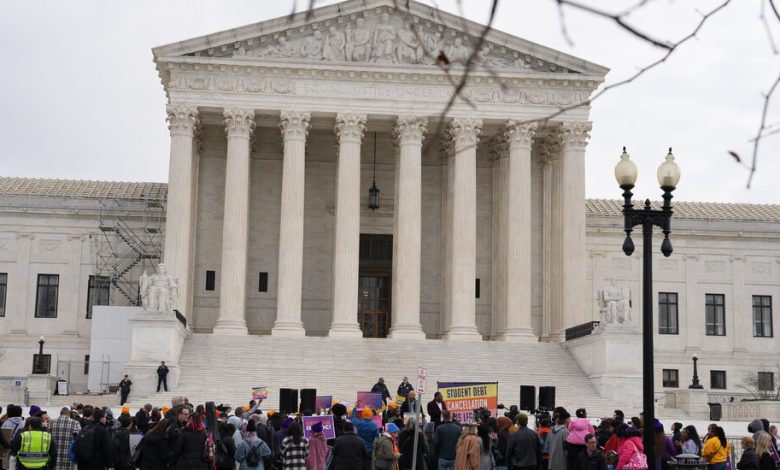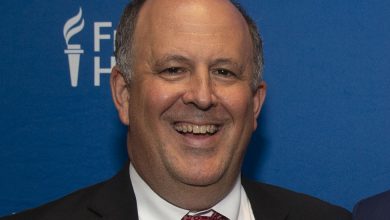The Student Loan Payment Pause Is Ending. Here’s How to Prepare.

After a three-year break, student loan payments are about to come due again.
The payment pause on federal loans has been extended eight times since March 2020 as part of a pandemic relief measure.
This time, however, the big restart has been written into legislation: As part of the agreement between President Biden and Speaker Kevin McCarthy to raise the debt ceiling, the pause button would be released “60 days after June 30,” or around Sept. 1. That isn’t much different from the timeline that Mr. Biden previously laid out, but codifying it may give him less leeway to extend the pause yet again.
The payment break has provided relief for roughly 27 million borrowers and another seven million in default, who received a reprieve from wage garnishment and other collection efforts. Interest had also stopped accruing during that time.
Your finances may look completely different from what they were three years ago, which is why borrowers should take a moment to evaluate where they stand — ideally well before loan servicers are crushed with calls and inquiries.
Here’s everything you need to know.
What’s the first thing I need to do?
Make sure your student loan servicer can find you. Go to your servicer’s website and verify that it has your latest contact details: email address, mailing address and phone number.
Not sure who your servicer is? Go to StudentAid.gov, find your account dashboard and scroll down to the “My Loan Servicers” section. You can also call the Federal Student Aid Information Center at 1-800-433-3243.
When will my payments restart? And how?
You should receive a notice or billing statement at least three weeks before your first payment is due, which should include your payment amount and due date. If you don’t want to wait, you can contact your servicer for that information now.
This is important: If you were on an automatic payment plan before the pandemic — that is, before March 13, 2020 — you must opt back in. Your servicer should reach out to you about this. If you don’t respond, your payments will not automatically restart.
If you signed up for autopay after that date, automatic payments will resume. Borrowers who have continued to make payments don’t have to do anything at all.
If you miss the first payment, don’t panic. Just contact your servicer and make arrangements to become current.
How will any potential loan cancellation be factored in?
Millions of borrowers could see up to $20,000 of their balance disappear if the Supreme Court allows the Biden administration to move ahead with its debt cancellation plan. (A decision is expected by the end of June.) The program would cancel $10,000 of debt for single individuals earning under $125,000 and married joint filers and heads of households with income under $250,000. Borrowers who received Pell Grants and fall under the income ceilings can qualify for another $10,000 in debt relief.
Debt cancellation would be automatic for borrowers who already submitted applications and had them approved, as well as those who didn’t need to apply because the government already had their information on file, borrower advocates said. Those who applied but haven’t yet received approval wouldn’t need to do so again.
Payments would be recalculated based on your new balance.
Payments for borrowers already enrolled in income-driven plans, however, generally wouldn’t change even if a portion of their debt was canceled. That’s because their payments are based on their discretionary income and household size.
I can’t afford my loan payment. What are my options?
Thankfully, federal borrowers have many options. But having so many choices can also be paralyzing, especially when they each have different eligibility rules and outcomes. But there are generally three categories:
Fixed payment plans: These include standard (fixed payments), graduated (your payments rise) and extended (you pay over a longer time) repayment plans.
Income-driven repayment plans: These plans base payments on your income and family size and may yield monthly payments as low as $0. After a couple of decades of payments, the government forgives whatever balance you’re still carrying. These plans will probably be the preferred option for many borrowers who struggle with making their payments.
Last resorts: Borrowers can also request deferment or forbearance, both of which temporarily put payments on hold — though there can be significant added costs in the long run. With forbearance, payments stop but interest still accrues. If the interest is not paid, it’s added to the loan’s principal balance. Deferment is similar, but subsidized loans — which generally have slightly better terms — won’t accrue interest while they’re paused.
Tell me more about income-driven plans.
The rules are complicated, but the gist is simple: Payments are based on your earnings and family size and readjusted each year. After you make monthly payments for a set number of years — usually 20, sometimes 25 — any remaining balance is forgiven. (The balance is taxable as income, though a temporary tax rule exempts balances forgiven through 2025 from federal income taxes.)
For now, there’s a confusing assortment of plans available. The alphabet soup includes PAYE (Pay as You Earn), REPAYE (Revised Pay as You Earn), I.C.R. (Income-Contingent Repayment) and two versions of I.B.R. (Income-Based Repayment). There’s yet another — more affordable — plan in development, but we’ll explain more down below.
Monthly payments are often calculated at 10 or 15 percent of discretionary income, but one plan is 20 percent. Under the existing plans, discretionary income is usually defined as the amount earned above 150 percent of the poverty level, which is adjusted for household size.
The formulas aren’t adjusted for local cost of living, private student loans or medical bills, among other things. But they remain a more manageable solution for many borrowers.
The Biden administration has proposed a less expensive income-driven plan. What’s the status?
The proposed plan would revise the existing income-driven plan known as REPAYE, and could reduce payments for millions of borrowers by more than half.
The Education Department released the proposal in January, and a final rule — which may have been tweaked from the initial proposal — was sent to the White House for review on May 23.
“They could pretty quickly approve it,” said Abby Shafroth, director of the Student Loan Borrower Assistance Project at the National Consumer Law Center, “or they could find issues and send it back to the Department of Education for revision.”
Even after a final plan is approved and published, it will take time to get up and running, so it’s hard to say when it will be open for enrollment.
How will the new plan work?
The proposed plan would become more generous in several ways. To start, it would reduce payments on undergraduate loans to 5 percent of discretionary income, down from 10 percent in the existing REPAYE plan.
Graduate debt is also eligible, but borrowers would pay 10 percent of discretionary income on that portion. If you held both undergraduate and graduate debt, your payment would be weighted accordingly.
The proposed plan would also tweak the payment formula so that more income was protected for a borrower’s basic needs, which would reduce payments overall. That change would also allow more low-income workers to qualify for zero-dollar payments.
Some borrowers wouldn’t get access, however: The new plan is not open to parents who borrowed to pay for their children’s schooling using Parent PLUS loans. They’re eligible for only one income-driven plan, I.C.R.
Once the revised REPAYE plan becomes available, the Biden administration has proposed simplifying the I.D.R. landscape and limiting new enrollment into certain plans.
Borrowers with Parent PLUS loans, however, would not lose access to the I.C.R. plan. They could continue to enroll in that plan after they consolidated into a so-called direct consolidation loan.
How do I choose the best plan?
The loan simulator tool at StudentAid.gov can help. It will guide you through the options and help you decide which plan best fits your goals.
And it’s easy to use. When you sign in, it should automatically use your loans in its calculations. (You can add other federal loans if any are missing.) You can also compare plans side by side — how much they’ll cost over time, both monthly and in total, and if any debt would be forgiven.
The new REPAYE plan is expected to provide the lowest payment for most borrowers. But until that becomes available, borrowers will have to choose among the existing alternatives.
I was in an income-driven plan. What happens now?
You’ll still be enrolled in the same plan. And there’s good news: All your months of paused payments are treated as if you had paid, which means that time counts toward the years you must accrue to have your loan forgiven.
Participants in an income-driven plan must recertify their income and family size each year to remain enrolled, but you won’t be asked to do this immediately — the earliest you will be asked is six months after the payment pause ends, experts said, or probably near the end of February.
You may want to do it sooner: If your income dropped or your family grew, updating your information is likely to lower your payment. To update your information, visit the I.D.R. application online and select the button next to “Recalculate My Monthly Payment.”
Many borrowers received credit on their payments, bringing them closer to loan forgiveness. How will I know if I will benefit and where my loan stands?
The Biden administration created a program to address administrative problems that long plagued the student loan system, particularly for borrowers enrolled in income-driven repayment plans and those seeking relief through its Public Service Loan Forgiveness program.
Millions of federal borrowers have received one-time account adjustments, which will revise their accounts so that more of their payments will count toward the required number of payments needed for loan forgiveness.
The adjustments also apply to borrowers who are not enrolled in income-driven repayment programs. This acknowledges that many financially distressed borrowers didn’t receive all of their options when they sought help from their loan servicers, or were steered into less helpful choices, like forbearance.
Most of these adjustments will happen automatically, but there are exceptions for loans that aren’t held by the Education Department. For more information, see my colleague Ann Carrns’s article.
An online payment tracker is in the works.
My loans were in default before March 2020. What is my status now?
Most borrowers who fell into default before March 2020 have a one-time chance to wipe the slate clean under the administration’s Fresh Start program. But some benefits are automatic, and others will require borrowers to take action.
First, the automatic: Borrowers in default will not be subject to collection efforts or have their wages garnished through roughly August 2024, which basically gives them one year after the payment pause lifts to make arrangements to get back on track. They are also permitted to apply for federal student loans again, as many borrowers in default haven’t completed degrees. And finally, defaulted borrowers’ loans are already being reported to the credit bureaus as being current.
But all of this is temporary unless you take some extra steps. Borrowers must contact their loan holder to keep their loans out of default for the long term. If they don’t take action, loans will fall back into default a year after the pause ends.
It’s pretty simple: Contact the Education Department’s Default Resolution Group — by phone, online or mail — and ask it to take your loans out of default through the Fresh Start program. It will transfer your loans to a regular loan servicer (which can take four to six weeks) and wipe the record of default from your credit report. Taking these steps will also restore access to income-driven repayment plans and forgiveness programs, including Public Service Loan Forgiveness.
I was behind on my payments. What are my options?
Delinquent borrowers will also receive a fresh start: Their accounts will be considered current.
That should remove the pressure for borrowers who were in danger of falling into default, which happens if you’re at least 270 days behind. If you were delinquent, find out what your payment is expected to be; if you still cannot afford it, consider enrolling in a different repayment plan that will lower your bill.
Where can I get more help?
Besides your servicer, groups like the Institute of Student Loan Advisors, known as TISLA, can provide free guidance on what options may best work for you. For New York State residents, EDCAP, a nonprofit focused on student loans, also offers help. And some employers and other organizations have hired companies like Summer, which helps borrowers sort through the options.
Borrowers need to be on high alert for scam artists offering debt relief and other services. If you’re unsure whether the help you’re being offered is legitimate, hang up, don’t respond to the email — and reach out to your servicer using the number printed on your bill or the government website. You can file complaints through the Federal Trade Commission and your state’s attorney general.



